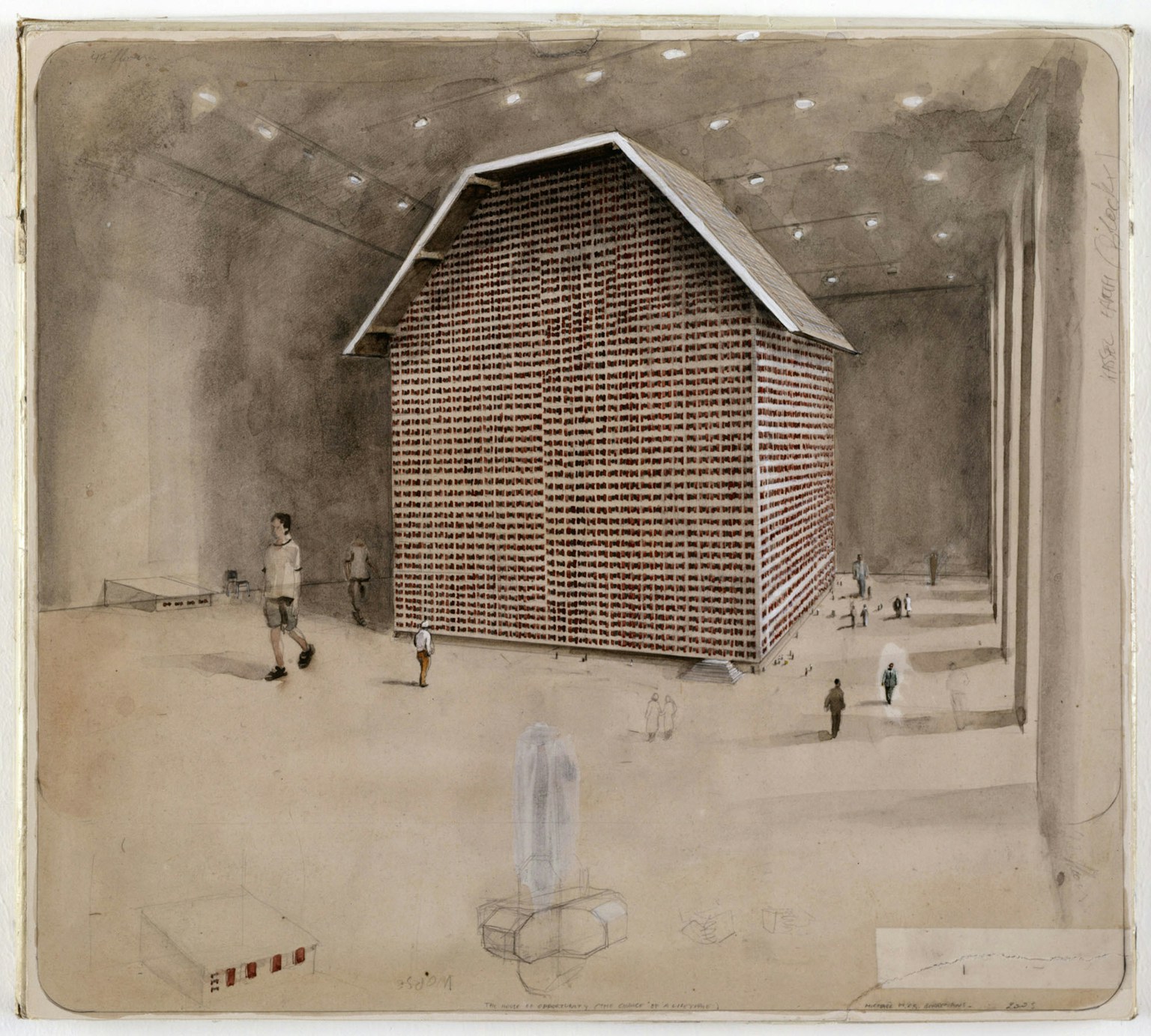Our group visits still cannot be restarted. Fortunately, we can continue to count on our guides. These fascinating storytellers also guide you into the museum via the digital route. Today, our guide is Piet Vanclooster.
"We are looking at a house. This is the first thing that strikes us when viewing ‘The House of Opportunity (The Chance of a Lifetime)’ (2003) by Michaël Borremans. It is an extremely familiar and immediately recognisable object: after all, we see a roof, walls, and so on.
Following our mental image of a house, we almost automatically start searching for other intrinsic elements, such as windows and doors. As they are not immediately discernible, we feel obliged to persist in figuring this out. We zoom in, and in one respect are relieved to find a series of elements that could represent windows, although they are so miniscule as to appear out of proportion to the overall scale of the house. Moreover, there are hundreds, perhaps even thousands of them, arranged in narrow rows that cover all of the walls. And the longer we focus on them, the more we begin to doubt whether they are, in fact, windows. Our focus consequently shifts. “A door, a house should at least have a door!” we assure ourselves. We keep searching but cannot immediately find one. Warped. We take a few steps back. Aha, perhaps there is something to reassure us here, after all. Surely there is a slight degree of subsidence in each of the rows of windows, more or less in the centre, that we imagined we just saw in the façade? And if we take a closer look, we can discern the contours of a gigantic door, one that runs from the bottom of the house almost up to the roof and back. However, we cannot be sure: these are only vague contours, which moreover – to cap it all – undermine what we only surmise to be rows of windows. If it really were a functioning door, would the windows also swing round as it opens?! But that’s impossible! We start to become vexed, but do not give up: a house should have a door and we’re jolly well going to find it! Once again, we go and stand closer to the painting and then zoom in on specific zones. After a while, we notice a staircase at the bottom right of the façade, and to the right of this, we believe we can make out a door, however microscopic, or something that at least resembles an entrance. Bizarre. Does the house now have a big or a small door? We are left in the dark. Michaël Borremans is clearly toying with us here, causing us to doubt ourselves and playing havoc with our mental image of one of the most familiar things of all – a house with windows and doors.
In the meantime, it has also struck us that there are people depicted in the painting who are walking or standing around the house, figures of various scales; and that right beside this small entrance that we have just described, microscopic people can be seen. What are they doing there and why are they all different sizes? Some are more fleetingly sketched, others even appear to be transparent. Are the latter actually there, or do they merely have a semblance of a presence?
When we refocus our attention on the foreground, we perceive a central, enigmatic, unfinished, hastily drawn, graffiti-like object. It has a phallic air. The artist has placed something mysterious here for us, and we are free to interpret it at will. One thing is clear: if we were to ask Borremans what this mysterious object is supposed to represent, he would not answer. Some people see a fountain in it, others a statue, still others a lamp because it appears to be emitting light. And to top it all, we see an aura of light around one of the mid-sized people standing to the right of the house. Perhaps the light from the lamp is illuminating that person? It occurs to you that it cannot be a coincidence that the strange object and that one person are both irradiated, and that the two must be linked in some way. But the precise manner of this connection escapes you entirely. The scene becomes increasingly enigmatic.
If we then zoom out again, it strikes us that the house is standing inside a large hall. The building in which it has been placed feels heavy, as though fashioned from reinforced concrete. It is as if the house were standing in a bunker. Yet the walls do not come across as being totally solid, for to the right we see what appears to be daylight shining inwards through a row of columns. At the top, in the ceiling, we see glowing spotlights. The painting as a whole, the house placed in a cavernous hall with people walking around it, exudes a certain atmosphere: there is something oppressive about it…
And now, in a fraction of a second, an uncanny sensation might well up in the viewer. Something of a different quality to the enigmatic nature of everything that we have described until now. However strange and mysterious things appeared, and no matter how intellectually uncertain we may have felt, all this seems like nothing when compared to an uncanny realisation, one that in a flash, at this precise moment, causes us to freeze.
This happens at the point when something starts to dawn on you, namely when you suddenly become aware of the space in which you are standing as a museum visitor, and you glance over your shoulder only to realise it is incredibly similar, almost identical in fact, to the large hall with the concrete walls in the painting in which the house is standing. To the left, behind us in the gallery in which the work is hung, we can also see daylight filtering through a row of columns. The same row of columns as in the painting! Moreover, we look up and see virtually identical spotlights in the ceiling of the museum room. And if the space in which we are standing, as museum visitors, is the same as the one in the painting, then who are the people who congregate around the house? Us, of course. We move ourselves into the painting. The consequence being, paradoxically enough, that we find ourselves both inside and outside the artwork. We see ourselves looking at a house inside a hall that is both real and painted. And this is not yet all, because in one and the same movement, the object depicted in the foreground of the painting is projected above us in the gallery in which we are actually standing. The strange phallic object in the foreground is dropped behind us in the room like an invisible Fremdkörper (in the sense of a foreign body). In other words, something threatens to appear in the room in which we find ourselves, a thing that does not, in reality, exist. And by extension, we see ourselves appear – lit up – in the painting along with the Fremdkörper, as an illusion. We are no longer in one of the S.M.A.K. galleries, but in the painting!
All of this occurs in the blink of an eye, it is a short-circuit moment. Until that point, we were in control of our viewing, despite our intellectual uncertainty, despite the lack of overall clarity, despite the multiple questions we kept asking ourselves. It is in this moment, however, that everything starts to shift: the space in which we are standing is deduplicated and we, as viewers, are buffeted around. We lose the solid ground under our feet…"
Piet Vanclooster
Piet Vanclooster’s primary profession is that of psychotherapist/psychoanalyst and since the exhibition of Raoul De Keyser’s oeuvre (September 2018), he has been a valued member of our team of guides. Piet also developed and acted as guide for a series of unique introductory guided tours for our visitors. ‘Aan de rand van de schilderkunst‘ (On the boundaries of painting’) to accompany Roaul De Keyser, and during the Highlights for a Future exhibition ‘Het Unheimliche in de actuele kunst’ (‘The uncanny in contemporary art’).
GROUP VISITS
We hope to allow group visits again but this is subject to what the National Security Council will decide in the future.
Through this link you will find all the information.

















